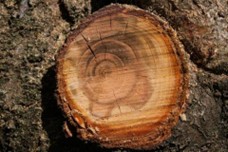Wound Sealant for Trees

This month’s myth or misconception is one that I commonly get asked variations of throughout the year when someone is pruning a tree, has a tree damaged by a storm, or has a crack in the tree’s bark. It is a common belief that we should paint or seal the wounds we make in trees, just like we do with bandages when we have cuts or scrapes on our skin.
In decades past, recommendations were often made to apply tree paint to wounds. The idea was that this paint would prevent decay, help speed healing, and improve the appearance of the cut. Although these claims have been debunked for years, many tree wound dressing products can be purchased online or at garden supply stores. Many are petroleum-based and advertised as waterproof and flexible to keep insects and fungi from invading the pruned areas. Better yet, some of these products claim they can be used for multiple purposes, from waterproofing and sealing gutters and roof flashings, to protecting the undersides of lawnmower decks. These materials don’t seem like they would be healthy to apply to living tissue.
The reality is that pruning paint may impede healing and encourage the growth of rot organisms and insect infestation. Rather than seal out infection, wound dressings often seal in moisture and decay. In most cases, it is best to let wounds seal on their own. Over millennia, trees have developed effective mechanisms for this. Unlike people or animals, woody plants are unable to heal damaged tissues. Instead, they compartmentalize wounds with layers of cells that prevent damage from spreading any further. A properly pruned tree or shrub will be able to seal off the wound and prevent further damage. Remember to use the three-cut method to prevent bark from being torn when pruning. Bigger wounds will take longer to heal, but they will heal in their own time.
The exact process applies to trees damaged in storms and those that have developed cracks in their bark. They will heal in their own time without any help. I have heard of people wanting to fill holes in the tree with cement or other products to seal it up. Although it may be tempting to plug a large opening with cement or foam, neither of these materials will bond with the wood of the tree, and they will hold moisture, speed the development of wood decay fungi, and obstruct the natural compartmentalization process. The best option is to monitor the area and let nature take its course.

Have questions? Contact our office where our Horticulture Extension Agent will assist you with questions.
Phone: (316) 321-9660
Email: callae@ksu.edu